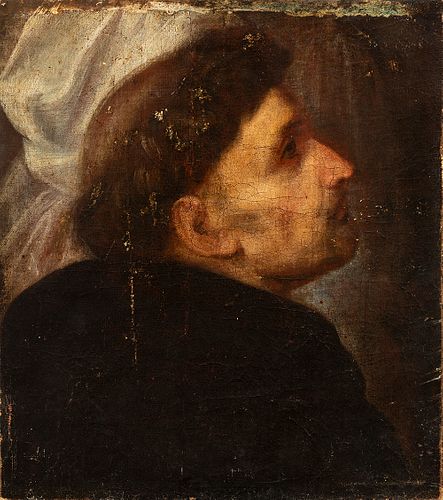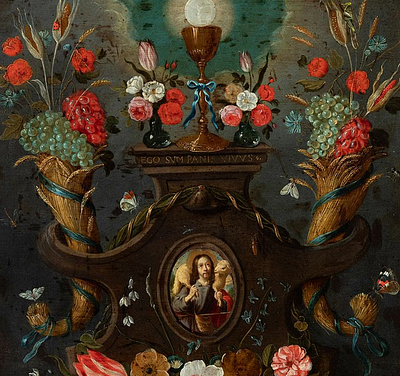Spanish school; second half of the 17th century. "San Antonio de Padua". Oil on canvas. Re-coloured.
Lot 15
About Seller
Setdart Auction House
Carrer Aragó 346
Barcelona
Spain
Setdart Subastas was born in 2004 and is currently the first online art auction in Spain with solidity, prestige and reliability guaranteed by our more than 60,000 users. Setdart has a young, dynamic and enterprising team ready to successfully manage the purchase and sale of art works through custom...Read more
Estimate:
EUR€700 - EUR€900
$736.84 - $947.37
Absentee vs Live bid
Two ways to bid:
- Leave a max absentee bid and the platform will bid on your behalf up to your maximum bid during the live auction.
- Bid live during the auction and your bids will be submitted real-time to the auctioneer.
Bid Increments
| Price | Bid Increment |
|---|---|
| EUR€0 | EUR€10 |
| EUR€200 | EUR€25 |
| EUR€500 | EUR€50 |
| EUR€1,000 | EUR€100 |
| EUR€3,000 | EUR€200 |
| EUR€5,000 | EUR€500 |
| EUR€10,000 | EUR€1,000 |
| EUR€20,000 | EUR€2,000 |
| EUR€50,000 | EUR€5,000 |
About Auction
By Setdart Auction House
Sep 21, 2021
Set Reminder
2021-09-21 10:00:00
2021-09-21 10:00:00
America/New_York
Bidsquare
Bidsquare : 21st September - ARAS JÁUREGUI Private Collection - Old Masters, 19th & 20th Century
https://www.bidsquare.com/auctions/setdart-auction-house/21st-september---aras-j-uregui-private-collection---old-masters-19th-20th-century-7429
Setdart Auction House sofia@setdart.com
Setdart Auction House sofia@setdart.com
- Lot Description
Spanish school; second half of the 17th century. "San Antonio de Padua". Oil on canvas. Re-coloured. It has faults and repainting. It is a fragment of a bigger painting. Measurements: 29 x 25 cm. Saint Anthony of Padua is, after Saint Francis of Assisi, the most popular of the Franciscan saints. He was born in Lisbon in 1195 and only spent the last two years of his life in Padua. After studying at the convent of Santa Cruz in Coimbra, he entered the Order of Friars Minor in 1220, where he changed his Christian name from Fernando to Antonio. After teaching theology in Bologna, he travelled through southern and central France, preaching in Arles, Montpellier, Puy, Limoges and Bourges. In 1227 he took part in the general chapter at Assisi. In 1230 he was involved in the transfer of the remains of St. Francis. He preached in Padua and died there at the age of 36 in 1231. He was canonised only a year after his death, in 1232. Until the end of the 15th century, the cult of St. Anthony remained localised in Padua. From the following century onwards, he became, at first, the national saint of the Portuguese, who placed the churches they built abroad under his patronage, and then a universal saint. He was invoked for the rescue of shipwrecked sailors and the liberation of prisoners. Portuguese sailors invoked him for good wind in the sails, fixing his image on the mast of the ship. Nowadays he is invoked above all to recover lost objects. However, there is no trace of this last patronage before the 17th century. It seems to be due to a play on words with his name: he was called Antonio de Pade or de Pave, an abbreviation of Padua (Padova). From there, he was attributed with the gift of recovering epaves, i.e. lost property. He is depicted as a beardless young man with a broad monastic tonsure, dressed in a habit, and often appears with the Infant Jesus, holding him in his arms, alluding to an apparition he had in his cell. It became the most popular attribute of this saint from the 16th century onwards, being especially popular in the Baroque art of the Counter-Reformation.
- Shipping Info
-
In-house shipping available. Please inquire at admin@setdart.com.
-
- Buyer's Premium



 EUR
EUR CAD
CAD AUD
AUD GBP
GBP MXN
MXN HKD
HKD CNY
CNY MYR
MYR SEK
SEK SGD
SGD CHF
CHF THB
THB















